Here I am in Uyuni, 5 days after our tour ended, still waiting for my keys. It's back another era here with the communication, as I said in the last post the only way to communicate with the town I left them in is by CB Radio. So it's my CB Radio operator attempting to communicate with the only radio in the town of Quetena Chico. The method is that she goes on one of the 5 open frequencies and says "Quetena Chico-Quetena Chico-Quetena Chico-Quetena Chico?". Then waits a couple of seconds for a response before repeating. On the same frequencies at the same time are other voices of other users looking for someone in the town they're trying to contact: "Tupiza-Tupiza-Tupiza-Tupiza-Tupiza?". But I'm usually not the only one in the radio office trying to get hold of someone, sometimes they'll be 3 or 4 of us so she'll put the call out for all of them at the same time: "Quetena Chico Tupiza Tupiza Montaña Montaña Serena Serena Quetena Chico?". If I'm lucky after about half an hour of that she'll get hold of the radio operator there, and he'll pass a message to the hotel owner or arrange to call back at a later time, at which point I have to come back and the whole process repeats again. It's just my luck that the place I'm calling is probably the smallest, as we hardly ever get through to Quetena Chico but the other users usually get through a lot quicker, and proceed to have a conversation about Dad's new job and yes, we're all doing fine here thanks Mum, which the rest of us listen to while we're waiting.
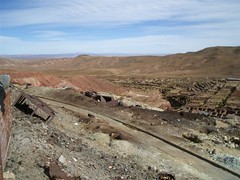
Overlooking the former miner's quarters at right, now ruins, Pulacayo
A couple of days ago I hired a mountain bike and got a ride on a bus to Pulacayo, 22km away. Pulacayo is the site of what was the world's second largest silver mine in the 1800s (second to Broken Hill in Australia). It was this mine that had Butch Cassidy and the Sundance Kid coming to Bolivia, not that of Potosí as I wrote earlier. The mine at Potosí was the world's biggest in the 1600s through to the 1800s, but Pulacayo took over in the 19th century. I turned up with my bike and rode around the tiny town for about half an hour, not really knowing where the mine was or what to see. The few people I passed were all very friendly, everyone offering a
buenos tardes (Good afternoon). I asked some kid on a BMX what's there to see in this town and he showed me around a bit. Eventually I returned to the tourist info office which was closed earlier, and met a guide who offered to give me a paid tour, which I took him up on.
Usually I don't like tours as you feel too much like a sheep being led around the place, but I didn't really know anything about this place and the guide named Angel was great, he knew everything about the history of the place, and told me that at one point it had 35,000 inhabitants and was the second largest town in Bolivia. And how the mine was run by European engineers who had to abandon it following the 1952 Bolivian revolution (which had it's roots in this then city, with the 1946
Tesis de Pulacayo), and how the new Bolivian owners had no idea how to run the technology the Europeans subsequently left behind, so it was closed down in 1956. Today the town has a tiny population of 600, largely farmer's families but also a small workforce that works the mine using primitive methods, or sorting through the debris left behind from its heyday for any leftovers.
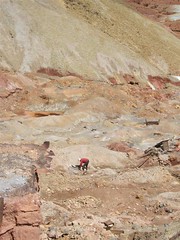
A woman looking for rocks
The mine itself is full of silver, lead, and zinc. The scroungers (all women) put a pile of rocks into a bucket filled with water, shake it up with a kind of sive, and the ones that sink faster have elements inside. Each rock usually has a mixture of the 3 elements. The rocks are ground up into smaller rocks, with which each worker fills his bags. Once a month a truckload comes and everyone's bags are taken to the mineral market in Oruru, where a sample taken from each bag is analysed for mineral content and the miner paid accordingly.
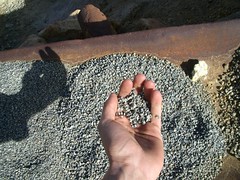
Ground rocks ready for bagging
Angel also filled me in with a bit more of the Butch Cassidy story, showing me one of the trains that Butch Cassidy robbed in 1912 for it's payroll. He said that although in the movie Butch Cassidy and Sundance were both killed in the shootout in San Vincente, in reality it was only Butch Cassidy who was killed by the Bolivian Police and US bounty hunters, and that they'd parted earlier and the Sundance Kid was then in Argentina.
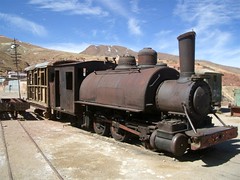
Butch Cassidy robbed this train in 1912
Near the town entrance there were half a dozen abandonded locomotives, but unlike the train cemetary near Uyuni these were still preserved. However, these were a lot smaller, being smaller narrow-gauge locomotives. Angel explained to me how prior to the locomotives they used to take the silver, lead and zinc to the Pacific (when Bolivia had still had a coastline before in was annexed by Chile in a war) by horse and cart, 120 carts in a huge convey. The trip would take 3 months each way so a 6 month round trip. The locomotives were then a huge investment, especially since Bolivia had no coal reserves so had to import the trains and then the coal to run them. Later, when they discovered oil reserves in Bolivia they converted the steam locomotives to run on petrol instead - the coal wagon got made into a tank, and a hose fed petrol into the boiler instead of a shovel feeding the boiler coal. Everything for the miners was imported too, shoes from Italy, clothes from France, cashmeres from England. Of course the miners, being peasants, had no idea the value of a pair of Italian shoes and as was often the case the ones making money during a goldrush weren't the miners but the storekeepers who supplied them.
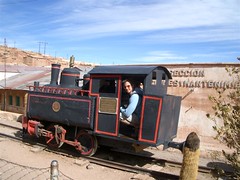
Not a toy train for kids, but one built for the 3m high, 3km long tunnel
After the tour I left town on the bike and headed back to Uyuni. When the mine closed the trains stopped being used, and recently they've dug up and removed all the old railway track, which now makes a nice mountain bike trail. And I was told it was mostly downhill. I had a hard time getting out of town as I had to climb a bit of a hill, and at 4200m once you lose your breathe the recovery time is pretty long. Still, I haven't had any other problems with the altitude. After that the ride was pretty good, once I'd found my way to the old train track. One of the gorges I went through was where Butch had held up the train I'd just seen in Pulacayo. Eventually I came to a part where the trail was washed out so I had to continue the rest of the way on the public dirt road. As I crested a hill I got a great view of the sunset, and although I stopped to take photos I knew I'd freeze as soon as it got dark so I had to rush the last 10km, arriving back in Uyuni in the pitch black at 7pm.
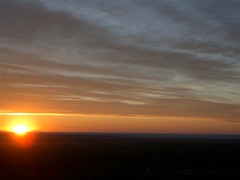
Sunset. The Salar de Uyuni is on the horizon at right, looking bluish
Right. I still haven't gotten my keys back as there's been no traffic at all passing through the hotel for Uyuni. So tomorrow I'm leaving anyway, but I've left behind a stamped and addressed envelope for the Poste Restante in La Paz, so if my keys arrive hopefully someone at the hotel will send them on to me. I've already spent 5 days here waiting for them, but at least I've been able to catch up on the blog and my email during that time!





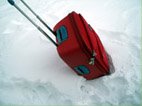
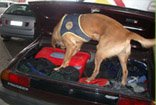

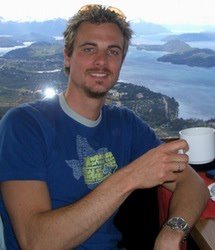


0 Comments:
Post a Comment
<< Home